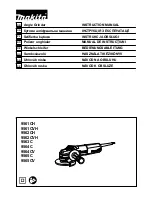
CSP
−
E
−
1
ROTORCRAFT FLIGHT MANUAL
Performance Data
MD 500E
(Model 369E)
Revision 14
5
−
8
FAA Approved
5
−
5. HOVER CEILING VS GROSS WEIGHT
−
IN GROUND EFFECT (IGE)
Description:
The hover ceiling charts show the maximum hover weight capability in
ground effect (IGE) for known conditions of pressure altitude and outside
air temperature (OAT), or alternately, the maximum hover ceiling for a
known gross weight and outside air temperature.
Ensure that the appropriate hover ceiling chart for type of engine
and optional equipment installed is selected prior to determining
IGE hover performance.
The Hover Ceiling vs Gross Weight charts are based on:
1. Takeoff power at 103 % N
2
2. Cabin heat and engine anti−ice OFF
3. Electrical load of 10 amps
NOTE
:
Controllability during downwind hovering, sideward and rearward flight has been
demonstrated to be adequate in winds up to 17 knots.
Use of Chart:
The following example explains the correct use of the chart in Figure 5−4.
To determine the maximum gross weight for hovering at 3.5ft skid height,
the pilot must know the pressure altitude and the outside air temperature.
Example
WANTED:
Maximum gross weight for hover at 3.5 feet skid height at
takeoff power.
KNOWN:
PA = 8000 feet; OAT = 25
°
C
METHOD:
Select the appropriate chart and enter the chart at 8000 PA.
Move horizontally across to the 25
°
OAT line. At this point, move direct-
ly down to the bottom of the chart and read off the gross weight scale:
2700 pounds.
If mist eliminator is installed, reduce weight capability by 40 LBS, or
2660 LBS.
This chart may also be used to determine maximum pressure altitude for
hovering at 3.5 feet skid height if the gross weight and the outside air tem-
perature are known. Enter the bottom of the chart at the known gross
weight,moveup totheknown OAT, move left and read the maximum hov-
er ceiling pressure altitude.
WARNING
















































